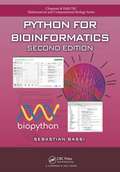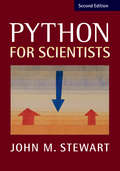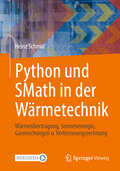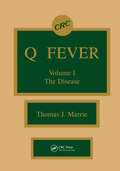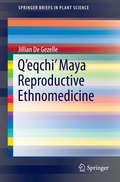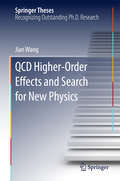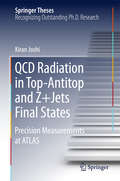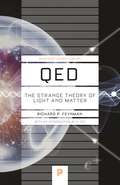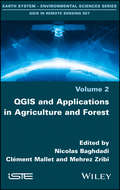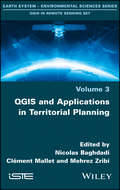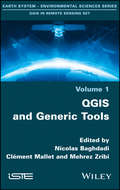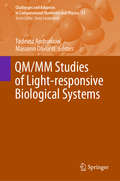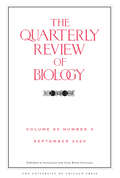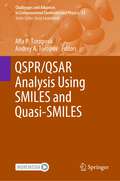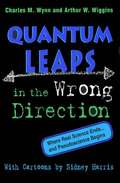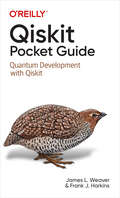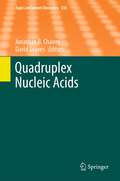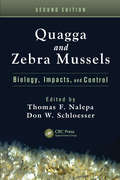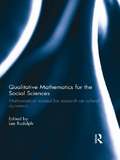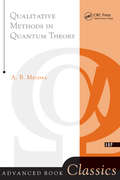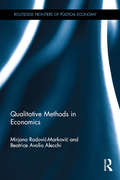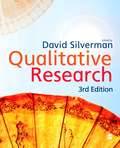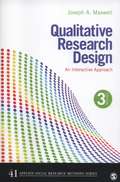- Table View
- List View
Python for Bioinformatics (Chapman & Hall/CRC Mathematical and Computational Biology)
by Sebastian BassiIn today's data driven biology, programming knowledge is essential in turning ideas into testable hypothesis. Based on the author’s extensive experience, Python for Bioinformatics, Second Edition helps biologists get to grips with the basics of software development. Requiring no prior knowledge of programming-related concepts, the book focuses on the easy-to-use, yet powerful, Python computer language. This new edition is updated throughout to Python 3 and is designed not just to help scientists master the basics, but to do more in less time and in a reproducible way. New developments added in this edition include NoSQL databases, the Anaconda Python distribution, graphical libraries like Bokeh, and the use of Github for collaborative development.
Python for Scientists
by John M. StewartPython is a free, open source, easy-to-use software tool that offers a significant alternative to proprietary packages such as MATLAB and Mathematica. This book covers everything the working scientist needs to know to start using Python effectively. The author explains scientific Python from scratch, showing how easy it is to implement and test non-trivial mathematical algorithms and guiding the reader through the many freely available add-on modules. A range of examples, relevant to many different fields, illustrate the program's capabilities. In particular, readers are shown how to use pre-existing legacy code (usually in Fortran77) within the Python environment, thus avoiding the need to master the original code. Instead of exercises the book contains useful snippets of tested code which the reader can adapt to handle problems in their own field, allowing students and researchers with little computer expertise to get up and running as soon as possible.
Python for Scientists
by John M. StewartPython is a free, open source, easy-to-use software tool that offers a significant alternative to proprietary packages such as MATLAB and Mathematica. This book covers everything the working scientist needs to know to start using Python effectively. The author explains scientific Python from scratch, showing how easy it is to implement and test non-trivial mathematical algorithms and guiding the reader through the many freely available add-on modules. A range of examples, relevant to many different fields, illustrate the program's capabilities. In particular, readers are shown how to use pre-existing legacy code (usually in Fortran77) within the Python environment, thus avoiding the need to master the original code. Instead of exercises the book contains useful snippets of tested code which the reader can adapt to handle problems in their own field, allowing students and researchers with little computer expertise to get up and running as soon as possible.
Python und SMath in der Wärmetechnik: Wärmeübertragung, Sonnenenergie, Gasmischungen u. Verbrennungsrechnung
by Heinz SchmidDieses Buch verbindet Ingenieurstheorie, Thermodynamik und Wärmeübertragung mit Softwareanwendungen wie SMath, MathCAD und Python. Es ist kein klassisches Lehrbuch, behandelt jedoch die grundlegenden Gleichungen und kommentiert Python-Programme. Zudem wird die Entwicklung von Wärmeaustauscher-Programmen mit Python-GUIs thematisiert, unter Nutzung leistungsstarker Bibliotheken. Querverweise zu aktuellen globalen Problemen wie dem Klimawandel und Lösungen, z.B. die Nutzung von grünem Wasserstoff, werden ebenfalls aufgezeigt.
Q Fever, Volume I: The Disease
by Thomas J. MarrieThis fascinating book describes the history, and epidemiology in both man and animals, and clinical features of this zoonosis. It reveals detailed information pertaining to the basic science aspects of the interaction of Coxiella burnetii, the etiologic agent of Q (Query) fever, with the host and the immune response of the host to this unique pathogen. This one-of-a-kind work uses the rules of epidemiological evidence to determine whether or not Coxiella burnetii is a perinatal pathogen for man. This interesting, easy-to-understand text concludes with chapters dealing with the antibiotic susceptibility of Coxiella burnetii and the studies that resulted in a vaccine that now can be used to prevent this infection. This volume is an absolute must for all microbiologists, respirologists, infectious disease physicians and veterinarians.
Q'eqchi' Maya Reproductive Ethnomedicine
by Jillian De GezelleThe Q'eqchi' Maya of Belize have an extensive pharmacopoeia of medicinal plants used traditionally for reproductive health and fertility, utilizing more than 60 plant species for these health treatments. Ten species were selected for investigation of their estrogenic activity using a reporter gene assay. Nine of the species were estrogenic, four of the species were also antiestrogenic, and two of the extracts were cytotoxic to the MCF-7 breast cancer cell line. Women's healing traditions are being lost in the Q'eqchi' communities of Belize at an accelerated rate, due to a combination of factors including: migration from Guatemala disrupting traditional lines of knowledge transmission; perceived disapproval by biomedical authorities; women's limited mobility due to domestic obligations; and lack of confidence stemming from the devaluation of women's knowledge. Q'eqchi' medicinal plant knowledge is highly gendered with women and men using different species in traditional health treatments. Revitalizing women's healing practices is vital for maintaining the traditional knowledge needed to provide comprehensive healthcare for Belize's indigenous communities.
QBism
by Hans Christian von BaeyerShort for Quantum Bayesianism, QBism adapts conventional features of quantum mechanics in light of a revised understanding of probability. Using commonsense language, without the equations or weirdness of conventional quantum theory, Hans Christian von Baeyer clarifies the meaning of quantum mechanics and suggests a new approach to general physics.
QCD Higher-Order Effects and Search for New Physics
by Jian WangThis book mainly investigates the precision predictions on the signal of new physics at the Large Hadron Collider (LHC) in the perturbative Quantum Chromodynamics (QCD) scheme. The potential of the LHC to discover the signal of dark matter associated production with a photon is studied after including next-to-leading order QCD corrections. The factorization and resummation of t-channel top quark transverse momentum distribution in the standard model at both the Tevatron and the LHC with soft-collinear effective theory are presented. The potential of the early LHC to discover the signal of monotops is discussed. These examples illustrate the method of searching for new physics beyond what is known today with high precision.
QCD Radiation in Top-Antitop and Z+Jets Final States
by Kiran JoshiThis thesis contains new research in both experimental and theoretical particle physics, making important contributions in each. Two analyses of collision data from the ATLAS experiment at the LHC are presented, as well as two phenomenological studies of heavy coloured resonances that could be produced at the LHC. The first data analysis was the measurement of top quark-antiquark production with a veto on additional jet activity. As the first detector-corrected measurement of jet activity in top-antitop events it played an important role in constraining the theoretical modelling, and ultimately reduced these uncertainties for ATLAS's other top-quark measurements by a factor of two. The second data analysis was the measurement of Z+2jet production and the observation of the electroweak vector boson fusion (VBF) component. As the first observation of VBF at a hadron collider, this measurement demonstrated new techniques to reliably extract VBF processes and paved the way for future VBF Higgs measurements. The first phenomenological study developed a new technique for identifying the colour of heavy resonances produced in proton-proton collisions. As a by-product of this study an unexpected and previously unnoticed correlation was discovered between the probability of correctly identifying a high-energy top and the colour structure of the event it was produced in. The second phenomenological study explored this relationship in more detail, and could have important consequences for the identification of new particles that decay to top quarks.
QED: The Strange Theory of Light and Matter (Princeton Science Library #33)
by A. Zee Richard P. FeynmanCelebrated for his brilliantly quirky insights into the physical world, Nobel laureate Richard Feynman also possessed an extraordinary talent for explaining difficult concepts to the general public. Here Feynman provides a classic and definitive introduction to QED (namely, quantum electrodynamics), that part of quantum field theory describing the interactions of light with charged particles. Using everyday language, spatial concepts, visualizations, and his renowned "Feynman diagrams" instead of advanced mathematics, Feynman clearly and humorously communicates both the substance and spirit of QED to the layperson. A. Zee's introduction places Feynman's book and his seminal contribution to QED in historical context and further highlights Feynman's uniquely appealing and illuminating style.
QGIS and Applications in Agriculture and Forest
by Nicolas Baghdadi Clément Mallet Mehrez ZribiThese four volumes present innovative thematic applications implemented using the open source software QGIS. These are applications that use remote sensing over continental surfaces. The volumes detail applications of remote sensing over continental surfaces, with a first one discussing applications for agriculture. A second one presents applications for forest, a third presents applications for the continental hydrology, and finally the last volume details applications for environment and risk issues.
QGIS and Applications in Territorial Planning
by Nicolas Baghdadi Clément Mallet Mehrez ZribiThese four volumes present innovative thematic applications implemented using the open source software QGIS. These are applications that use remote sensing over continental surfaces. The volumes detail applications of remote sensing over continental surfaces, with a first one discussing applications for agriculture. A second one presents applications for forest, a third presents applications for the continental hydrology, and finally the last volume details applications for environment and risk issues.
QGIS and Generic Tools
by Nicolas Baghdadi Clément Mallet Mehrez ZribiThese four volumes present innovative thematic applications implemented using the open source software QGIS. These are applications that use remote sensing over continental surfaces. The volumes detail applications of remote sensing over continental surfaces, with a first one discussing applications for agriculture. A second one presents applications for forest, a third presents applications for the continental hydrology, and finally the last volume details applications for environment and risk issues.
QM/MM Studies of Light-responsive Biological Systems (Challenges and Advances in Computational Chemistry and Physics #31)
by Tadeusz Andruniów Massimo OlivucciThis book, a consecutive contribution to the series Challenges and Advances in Computational Chemistry and Physics, focuses on understanding the photoinduced processes in biological systems. Understanding and fine control of light fate in molecules is vital for the progress of society and environmental safety. Light induced changes of various physico-chemical and spectroscopic properties in nucleic acids and proteins is the basis of fundamental biological events such as vision, DNA photodamage or photosensing. The investigation of these processes is challenging to both theoretical and experimental studies. This volume encompasses the quantum mechanics/molecular mechanics theory in several subfields, including: advanced computational methods for nucleic acids and proteins systems; dynamics, spectroscopic and physico-chemical properties of biological photoreceptors; DNA photodamage. This book is of interest to readers in both fundamental and application-oriented research by overviewing recent achievements in computational modeling of excited states in nucleic acids and proteins.
QRB vol 95 num 3
by The University of Chicago PressThis is volume 95 issue 3 of The Quarterly Review of Biology. The Quarterly Review of Biology (QRB) has presented insightful historical, philosophical, and technical treatments of important biological topics since 1926. As the premier review journal in biology, the QRB publishes outstanding review articles of generous length that are guided by an expansive, inclusive, and often humanistic understanding of biology. Beyond the core biological sciences, the QRB is also an important review journal for scholars in related areas, including policy studies and the history and philosophy of science. A comprehensive section of reviews on new biological books provides educators and researchers with information on the latest publications in the life sciences.
QSPR/QSAR Analysis Using SMILES and Quasi-SMILES (Challenges and Advances in Computational Chemistry and Physics #33)
by Alla P. Toropova Andrey A. ToropovThis contributed volume overviews recently presented approaches for carrying out QSPR/QSAR analysis by using a simplifying molecular input-line entry system (SMILES) to represent the molecular structure. In contrast to traditional SMILES, quasi-SMILES is a sequence of special symbols-codes that reflect molecular features and codes of experimental conditions. SMILES and quasi-SMILES serve as a basis to develop QSPR/QSAR as well Nano-QSPR/QSAR via the Monte Carlo calculation that provides the so-called optimal descriptors for QSPR/QSAR models. The book presents a reliable technology for developing Nano-QSPR/QSAR while it also includes the description of the algorithms of the Monte Carlo optimization. It discusses the theory and practice of the technique of variational authodecoders (VAEs) based on SMILES and analyses in detail the index of ideality of correlation (IIC) and the correlation intensity index (CII) which are new criteria for the predictive potential of the model. The mathematical apparatus used is simple so that students of relevant specializations can easily follow. This volume is a valuable contribution to the field and will be of great interest to developers of models of physicochemical properties and biological activity, chemical technologists, and toxicologists involved in the area of drug design.
QUANTUM LEAPS in the Wrong Direction Where Real Science Ends... and Pseudoscience Begins
by W. WigginsAstrology... poltergeists and ghosts... firewalking... spontaneous human combustion... psychic surgery... ESP. This is the stuff of tabloid headlines. Sure, many people find them laughable, but consider that these papers are all staying in business because people are buying them-and often believing in their outrageous stories, even labeling it all science.The fact is that not all "science" is created equally. Indeed, some "science" isn't science at all but is really downright bogus-in other words, pseudoscience. However, separating the wheat from the chaff might not be as easy as you think when you consider how many people are seduced by the headlines that surround them in the supermarket line. UFOs and creationism certainly have their advocates among intelligent and educated people. Sometimes, though, wrongly held beliefs can get you into real trouble.Consider the proclamation by Marshall Applewhite: "Planet Earth about to be recycled. Your chance to survive-leave with us." In April 1997, 39 people-believing just that-committed suicide in their communal home in Rancho Sante Fe, California. They hoped to shed their earthly "containers" and be whisked away by extraterrestrials to a spaceship and, ultimately, a higher level of existence. Unfortunately, their tragically misguided belief in the pseudoscientific claim of Marshall Applewhite cost them their lives.Quantum Leaps in the Wrong Direction takes us on a tour of the most notorious instances of pseudoscience and sets the record straight. To clearly demonstrate what is wrong with this brand of ersatz science, the authors look closely at what's right about real science, and then compare the true scientific approach with that of pseudoscience. Readers learn that science's most basic value is that all ideas about reality are subject to testing by experiment and challenge by critical, rational thought.Scientifically literate thinkers accept ideas tentatively. They base their acceptance on evidence rather than on authority. People who are not scientifically literate are more likely to accept ideas absolutely. They are more vulnerable to deficient or phony ideas. Quantum Leaps in the Wrong Direction draws the line between what is good science and what isn't even really science at all.The basis for the book begins with the examination of the five most widely believed pseudoscientific ideas: UFOs, out-of-body experiences, astrology, creationism, and ESP These ideas are reviewed in detail to see just how well they stand up to scientific scrutiny. Cleverly illustrated with cartoons by the renowned Sidney Harris, Quantum Leaps in the Wrong Direction is both wonderful fun as well as illuminating science.Although many science topics can seem mysterious, especially when you really get into the details, in the long run its methods and ideas are remarkably straightforward. Quantum Leaps in the Wrong Direction takes this methodical approach to dissect the worst in the field. Tremendously witty, disarmingly fun, this is a book for anyone-especially for those folks who check their horoscope everyday.
Qiskit Pocket Guide: Quantum Development with Qiskit
by James L. Weaver Frank J. HarkinsThe quantum computing market is predicted to grow by nearly $1.3 billion over the next five years. Why? Given their quantum mechanical nature, quantum computers are expected to solve difficult problems in chemistry, optimization, finance, and machine learning that classical computers find impossible to unravel.This pocket guide provides software developers with a quick reference to Qiskit, an open source SDK for working with quantum computers. Packed with helpful programming examples, tables, figures, and lists, this handy book helps you find the information you need to develop and debug quantum programs.Whether you're focused on business, engineering, or scientific applications, you'll learn how to choose and apply appropriate Qiskit classes, methods, and functions.Learn how to create quantum circuits, define quantum gates, and leverage the transpilerExplore modules for implementing quantum information concepts and quantum algorithmsSurvey features of Qiskit that abstract and facilitate working with various quantum computers and simulatorsLearn how to use the latest version of the Open Quantum Assembly Language
Quadruplex Nucleic Acids
by David Graves Jonathan B. ChairesGaining Insights into the Small Molecule Targeting of the G-Quadruplex in the c-MYC Promoter Using NMR and an Allele-Specific Transcriptional Assay, by Christine E. Kaiser, Vijay Gokhale, Danzhou Yang and Laurence H. Hurley.- Higher-Order Quadruplex Structures, by Luigi Petraccone.- Investigation of Quadruplex Structure Under Physiological Conditions Using In-Cell NMR, by Robert Hänsel, Silvie Foldynová-Trantírková, Volker Dötsch and Lukás Trantírek.- Circular Dichroism of Quadruplex Structures, by Antonio Randazzo, Gian Piero Spada and Mateus Webba da Silva.- Molecular Crowding and Hydration Regulating of G-Quadruplex Formation, by Daisuke Miyoshi, Takeshi Fujimoto and Naoki Sugimoto.- Visualizing the Quadruplex: From Fluorescent Ligands to Light-Up Probes, by Eric Largy, Anton Granzhan, Florian Hamon, Daniela Verga and Marie-Paule Teulade-Fichou.- Calculation of Hydrodynamic Properties for G-Quadruplex Nucleic Acid Structures from in silico Bead Models, by Huy T. Le, Robert Buscaglia, William L. Dean, Jonathan B. Chaires and John O. Trent.- Energetics of Ligand Binding to G-Quadruplexes, Concetta Giancola and Bruno Pagano.- Tetramolecular Quadruplex Stability and Assembly, by Phong Lan Thao Tran, Anne De Cian, Julien Gros, Rui Moriyama and Jean-Louis Mergny.
Quagga and Zebra Mussels: Biology, Impacts, and Control, Second Edition
by Thomas F. Nalepa Don W. SchloesserThe introduction and rapid spread of two Eurasian mussel species, Dreissena polymorpha (zebra mussel) and Dreissena rostriformis bugensis (quagga mussel), in waters of North America has caused great concern among industrial and recreational water users. These invasive species can create substantial problems for raw water users such as water treatme
Qualitative Mathematics for the Social Sciences: Mathematical Models for Research on Cultural Dynamics (Cultural Dynamics of Social Representation)
by Lee RudolphIn this book Lee Rudolph brings together international contributors who combine psychological and mathematical perspectives to analyse how qualitative mathematics can be used to create models of social and psychological processes. Bridging the gap between the fields with an imaginative and stimulating collection of contributed chapters, the volume updates the current research on the subject, which until now has been rather limited, focussing largely on the use of statistics. Qualitative Mathematics for the Social Sciences contains a variety of useful illustrative figures, introducing readers from the social sciences to the rich contribution that modern mathematics has made to our knowledge of logic, structures, and dynamic systems. A beguiling array of conceptual systems, topological models and fractals are discussed which transcend the application of statistics, and bring a fresh perspective to the study of social representations. The wide selection of qualitative mathematical methodologies discussed in this volume will be hugely valuable to higher-level undergraduate and postgraduate students of psychology, sociology and mathematics. It will also be useful for researchers, academics and professionals from the social sciences who want a firmer grasp on the use of qualitative mathematics.
Qualitative Methods In Quantum Theory
by MigdalThis unique book, written by a leading Soviet theorist, is not a textbook of quantum mechanics but rather a compendium of the "tricks of the trade"-the methods that all practicing theoretical physicists use but few have set down in writing.
Qualitative Methods in Economics (Routledge Frontiers of Political Economy)
by Mirjana Radović-Marković Beatrice Avolio AlecchiDespite numerous books on research methodology, many have failed to present a complete, hands-on, practical book to lead college classes or individuals through the research process. We are seeing more and more scientific papers from all research fields that fail to meet the basic criteria in terms of research methods, as well as the structure, writing style and presentation of results. This book aims to address this gap in the market by providing an authoritative, easy to follow guide to research methods and how to apply them. Qualitative Methods in Economics is focused not only on the research methods/techniques but also the methodology. The main objective of this book is to discuss qualitative methods and their use in economics and social science research. Chapters identify several of the research approaches commonly used in social studies, from the importance of the role of science through to the techniques of data collection. Using an example research paper to examine the methods used to present the research, the second half of this book breaks down how to present and format your results successfully. This book will be of use to students and researchers who want to improve their research methods and read up on the new and cutting edge advances in research methods, as well as those who like to study ways to improve the research process.
Qualitative Research
by David SilvermanThis hugely successful textbook has been fully updated and revised to make it even more accessible and comprehensive than previous editions. New chapters have been added on a range of key topics, including grounded theory, research ethics and systematic review. This book draws on a stellar list of leading qualitative researchers, each of whom is writing on their own specialized area in qualitative research, but doing so in a way that is clear and accessible to students and those new to the field of qualitative methods. All chapters also have added features - such as internet links, questions for readers and recommended readings. Alongside its engaging and accessible style, these new features make Qualitative Research the ideal textbook for all students working within this field. This is a comprehensive and accessible first text on qualitative methods that boasts a who's who of leading qualitative methodologists and is a must-have book for any student involved in doing research.
Qualitative Research Design: An Interactive Approach (Third Edition)
by Joseph A. MaxwellQualitative Research Design: An Interactive Approach, Third Edition provides researchers and students with a user-friendly, step-by-step guide to planning qualitative research. Joseph A. Maxwell shows how the components of design interact with each other, and provides a strategy for creating coherent and workable relationships among these design components, highlighting key design issues. Written in an informal, jargon-free style, the book incorporates examples and hands-on exercises. "This book uses everyday language that will captivate students' attention and embed practical knowledge to supplement the technical. " --Gaetane Jean-Marie, University of Oklahoma "The key strengths of the text are the passion and the enthusiasm that Dr. Maxwell has for qualitative research after all these years. I feel I can also utilize these concepts on my own research team and take them out of the classroom and into research team meetings with colleagues. " --Deborah Gioia, University of Maryland, Baltimore "I really liked this book. I found myself taking notes and saying "yes" so many times because Maxwell captures the research process so well and provides many points worth quoting. As a faculty mentor, I particularly see the value of this book for my students who are conducting qualitative dissertations. " --Mary S. Enright, Capella University "The text is incredibly engaging and practical. . . So many of the issues raised in the book are central to qualitative research, yet often not explicitly discussed in 'public' venues. " - David Carlone, The University of North Carolina at Greensboro "I particularly like the interactive focus and believe that helps students to more realistically engage qualitative research design. It certainly lives up to its billing as a good guidebook, and I appreciate the fact that the author really concentrates on useful content, exercises, insights, and examples, and leaves extensive theory discussions to others. " - Sharon L. Caudle, Texas A & M University
